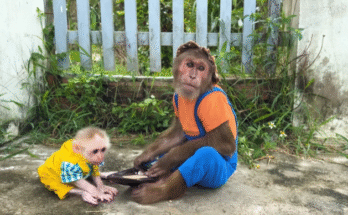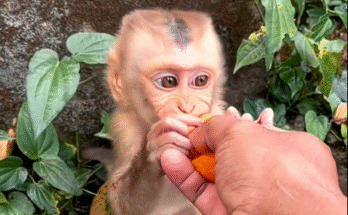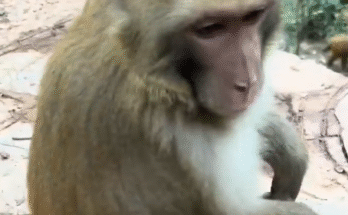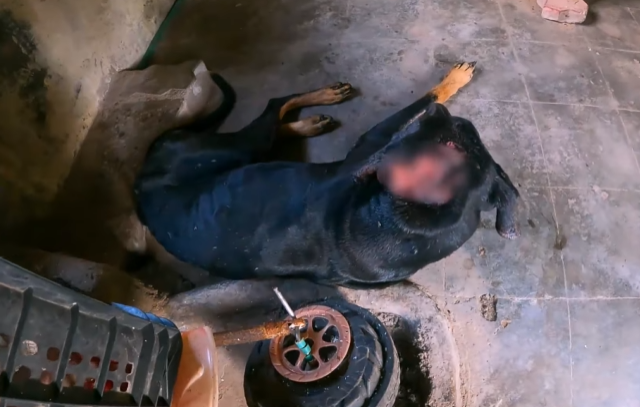
The morning had just begun when the call came in—a soft, shaky voice saying, “There’s a black stray dog near the old market… his head is covered in blood. I think… I think there are maggots.”
My heart dropped. Injuries like that were always severe, and maggot-infested wounds meant long, painful neglect. Without treatment, death was almost certain. I grabbed my rescue kit and rushed out the door, praying I wasn’t too late.
The old market was quiet when I arrived, the early light casting long shadows over abandoned stalls. A few shopkeepers pointed toward a narrow alley. “He’s over there,” one whispered. “He doesn’t let anyone get close.”
I followed their gestures until I reached the back of the market. That’s when I saw him—a thin, black dog curled beside a dumpster, trembling uncontrollably. His fur was patchy, his ribs visible, and his head… oh God, his head.
A deep, raw wound split across the top of his scalp. Dried blood had hardened along the edges, but the center was wet, alive with wriggling white maggots eating into the flesh. The smell was sickening—rot, infection, and suffering all mixed into one unbearable scent.
The dog lifted his head weakly when he sensed my presence. His eyes were not angry or wild—they were exhausted. Completely defeated.
He didn’t growl. He didn’t bark. He simply stared, as if asking quietly, Is this the end?
I knelt slowly, careful not to startle him. “Hey, boy,” I whispered. “I’m here to help. I promise.”
But promises mean nothing to a street dog who has survived only by fear and caution. When I reached out, he flinched violently and tried to stand. His legs gave out beneath him. He collapsed again with a heartbreaking whimper.
That was when I knew—he didn’t have much time left.
I had to act fast.
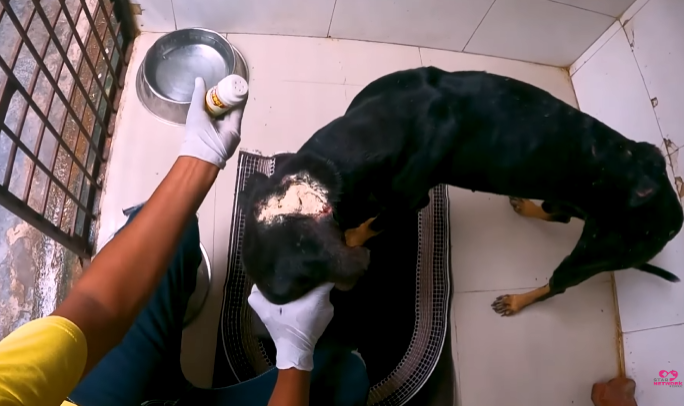
Using a blanket, I approached him gently, speaking softly with every movement. “It’s okay… I won’t hurt you.” He watched me with haunted eyes but didn’t resist when I finally wrapped him securely. His body was burning with fever, trembling with pain.
Carefully, I carried him to the car. His head lay against my arm, and every breath he took sounded like a struggle. It was clear he was moments away from giving up.
When we reached the clinic, the veterinary team rushed him inside. The vet, Dr. Nara, examined the wound and shook her head grimly.
“Severe maggot infestation… infection is advanced. He must have been suffering for days,” she said. “If we don’t remove the maggots and clean the wound immediately, he won’t survive.”
I nodded, swallowing the lump in my throat. “Do whatever it takes.”
The treatment began.
We sedated him gently, and for the first time, his body fully relaxed. It was heartbreaking to see him finally resting only because anesthesia allowed him escape from pain.
Then came the hardest part.
As Dr. Nara parted the fur around the wound, dozens of maggots wriggled deeper into the raw tissue. The wound was large and deep, with exposed flesh that had begun to rot. The smell filled the room, but none of us flinched—we had seen worse, but it never got easier.
Using forceps, saline, and antiseptic, we began the slow, delicate task of removing each maggot. Some had burrowed deep. Some were tiny larvae that could barely be seen without strong light. It took nearly an hour of steady hands and quiet focus.
Once the wound was finally clear, we flushed it thoroughly, applied medication, and bandaged it securely. The dog’s breathing steadied slightly, though he remained unconscious.
“He’s strong,” Dr. Nara murmured. “He’s been fighting alone for a long time.”
I touched his paw gently. “He won’t fight alone anymore.”

Recovery was uncertain.
The first few days were the most critical. He had a high fever, severe infection, dehydration, and malnutrition. We placed him on IV fluids, antibiotics, and pain control. He refused food at first, too weak even to lift his head.
But on the third day, he opened his eyes and looked at me—not with fear this time, but with a spark of curiosity, maybe even recognition.
I sat beside him every day, bringing soft blankets, stroking his fur gently, talking to him even when he was too weak to respond.
“You’re safe now,” I’d whisper. “You’re loved. Rest. Heal.”
Little by little, he responded.
On day five, he drank water on his own.
On day seven, he accepted a small bowl of soft food.
On day ten, he wagged his tail—just once, weakly, but it was enough to make me tear up.
He didn’t trust humans easily. Whenever someone new entered the room, he stiffened. But with me, he gradually softened. He began resting his head on my lap, leaning into my hand, letting out small sighs of relief as if finally understanding he wasn’t in danger anymore.
His name, I decided, would be Shadow—a quiet, gentle presence who had survived in the dark for too long.
Weeks passed, and Shadow’s transformation was nothing short of miraculous.
His wound, once a terrifying raw cavity teeming with maggots, began to close beautifully. New skin formed, tenderness replaced infection, and his fur started to grow back slowly around the edges. His appetite returned with surprising enthusiasm—he devoured meals as though making up for years of starvation.
His personality also blossomed.
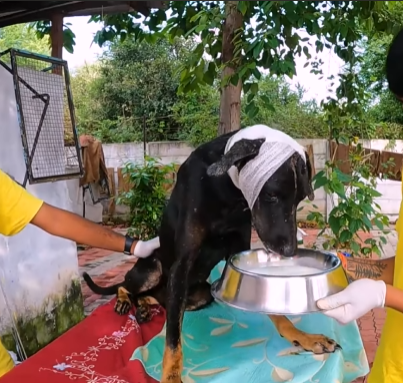
Shadow, once defeated and silent, began to show glimpses of joy. He learned to nudge my hand for more pets. He enjoyed short walks in the sunshine. He wagged his tail more confidently each day. Sometimes he even let out a soft playful bark, surprising both of us.
People at the clinic adored him.
The same dog who had been moments from death was now a symbol of resilience.
One afternoon, as I sat beside him in the recovery yard, Shadow leaned against me, pressing his warm body gently against my side. He lifted his head and looked into my eyes with a depth of gratitude I will never forget.
No words were needed.
He knew.
He remembered.
And he trusted.
After two months of dedicated care, Shadow was finally healthy enough to leave the clinic. I had fostered many dogs over the years, but Shadow… he was different. He had endured unimaginable pain, yet he gave love freely once he felt safe. He had fought for his life when many would have surrendered.
I couldn’t let him go.
Shadow came home with me, stepping into the house timidly at first, then exploring with cautious excitement. He sniffed every corner, every blanket, every toy—then curled up at my feet and sighed with contentment.
His journey from a dying stray with a maggot-infested wound to a beloved companion was nothing short of miraculous.
Today, his fur is shiny, his eyes bright with life, and his spirit full of warmth. He runs, plays, cuddles, and sleeps peacefully—everything a dog should have been allowed to do from the beginning.
Shadow’s story is not just a rescue story.
It is a story of survival, of healing, of trust rebuilt and hope restored.
It is proof that even the most broken can rise again—
with love, patience, and a chance.
And Shadow will never, ever suffer alone again.
